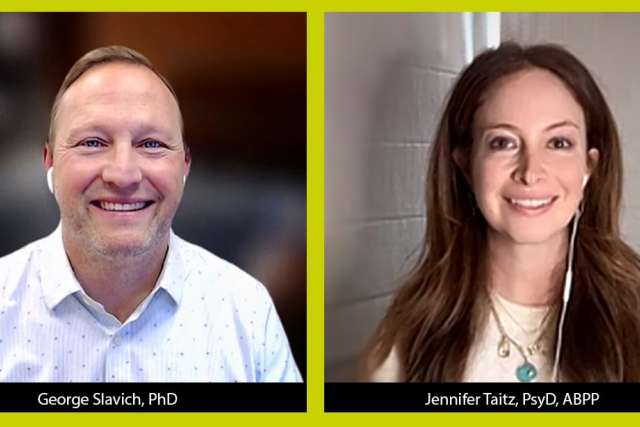What if there was a way to stop ruminating, overthinking and stressing that didn’t require drugs, escaping to a Himalayan mountaintop or dropping out of life altogether?
There is, says Jennifer Taitz, PsyD, an assistant clinical professor of psychiatry at UCLA Health and author of the new book “Stress Resets.” In fact, there’s not just one way to soothe stress quickly, but at least 75, which she outlines in her book.
Dr. Taitz shared some of her favorite stress-busting strategies during a recent virtual appearance at Open Mind, a free lecture series sponsored by the Friends of the Semel Institute for Neuroscience and Human Behavior. She was joined by George Slavich, PhD, director of the UCLA Laboratory for Stress Assessment and Research, a professor of psychiatry and biobehavioral sciences at UCLA Health and one of the experts featured in “Stress Resets.”
Dr. Taitz said she was inspired to write the book after reading a 2019 study that found listening to music could be as soothing as a sedative before surgery.
“This got me thinking about all of the ways we can easily and quickly improve how we feel in a matter of minutes,” she said. “I wanted to expand on this, because I don’t think we should just be putting out fires, but living a life that feels more like a buffer so we’re not just going from crisis to crisis. And these are all tools that I use myself as a mom of three little kids.”
While many people use benzodiazepines, such as Xanax or Klonopin, to deal with acute stress, Dr. Taitz generally discourages this approach, as these medications are habit-forming and can “undermine our ability to learn behavioral tools” like the ones she shares with clients and outlines in her new book.
These tools fall into three main buckets, she said: breaking free from stressful thoughts rather than escalating them; dealing with the body’s stress response; and learning to face personal encounters without being hijacked by our emotions.
During the hourlong conversation between Dr. Taitz and Dr. Slavich, the two psychologists shared a number of actionable strategies to reduce stress and boost resilience, most of which can be done in minutes without any professional assistance.
“Regardless of ability to afford therapy, I think everyone should have access to these tools,” Dr. Taitz said, adding that while not every strategy works for every individual, there are plenty of approaches to choose from.
Here are some of her favorites:
Sing your thoughts: “Singing your thoughts can totally take the stress out of them,” Dr Taitz said. So if you’re home on a Saturday night and the thought arises, “I’m such a loser,” play with that thought, she said, suggesting, “Sing that thought to the tune of ‘Do You Believe in Magic?’”
This approach makes it easier to see that we can laugh at and release the thoughts that don’t help us, Dr. Taitz said. She added that she’s come to consider thoughts that aren’t moving her life in the direction she wants as a kind of mental spam.
Practice panic: The pounding heart. The sweaty palms. Shortness of breath. Feeling dizzy or nauseous. These physical symptoms of panic are as unsettling as they are familiar.
“It’s really alarming and scary when all of a sudden, in an important moment, it feels like your body is rebelling against you,” Dr. Taitz said.
But knowing what symptoms are likely to arise for you in anxiety-provoking situations — a meeting with the boss, a turbulent flight — and recreating them in a safe environment is how to defuse them, she said: “You’re putting out the welcome mat for what you want to shield yourself against.”
For example, by spinning in a chair to experience dizziness or breathing through a straw to mimic a short-of-breath sensation — but intentionally triggering these feelings from the safety and comfort of home — “you uncouple what feels terrifying and see that it’s actually just temporary,” Dr. Taitz said. “Inviting in what seems dangerous, you’re in the driver’s seat … and it’s a lot easier to reclaim your life.”
Set down your stress: Our responses to stressors often prolong stressful feelings, the doctors said.
“It’s so easy to imagine something stressful happening at work that was maybe seven minutes, and seven hours later you’re venting about it and talking about it at length instead of doing something to be present in the moment,” Dr. Taitz said. “This is what really tortures us.”
Even those of us who feel like “professional ruminators” can learn to put these thoughts aside, she said.
One of the strategies she suggests in her book and mentioned during the conversation is a kind of mini cold plunge: Fill a salad bowl with ice water, hold your breath and submerge your face in the water for 30 seconds.
“It’s like jumping into a cold pool,” she said. “There’s no way you’re going to be on the same (mental) loop when you’re so physiologically transformed. This also really slows your heart rate, so it gets at the physiological and the psychological.”
While this strategy might not be for everyone, “It’s a quick way to jolt you out of your negative thinking,” Dr. Slavich said.
Take opposite action: “Emotions don’t just happen to us. We co-create them,” Dr. Taitz said. “And if we take a step back, we can realize that every emotion has a corresponding action.”
When we feel sad, we may want to withdraw. If we feel anxious, we may want to avoid. If we feel shame, we may want to hide.
“Doing those things, as instinctive as they feel, only perpetuates and exacerbates those emotions that we may want to change,” she said. “That starts with acting different than how you feel when acting how you feel will not help.”
Dr. Taitz shared a relatable example of opposite action from her own life: Say she planned to go to a gym class in the morning, but when she woke up, she felt like she wasn’t in the mood.
“That’s a very short inner dialogue,” she said, “because, of course, I’m wrong.”
Scheduling activities that will contribute to a feeling of accomplishment is one way to encourage this kind of opposite action, she said, because we can create such schedules from “a place of wisdom.”
“Opposite action sounds relatively easy, but it requires a lot of openness to be curious and to experiment with (the idea of) being open to doing something different if what I’ve been doing hasn’t been working,” Dr. Taitz said. “This is an incredible gift that we can give ourselves, to see that regardless of what’s been showing up in our lives, we can do differently. Peace of mind isn’t life being easy, but knowing we can count on ourselves.”



